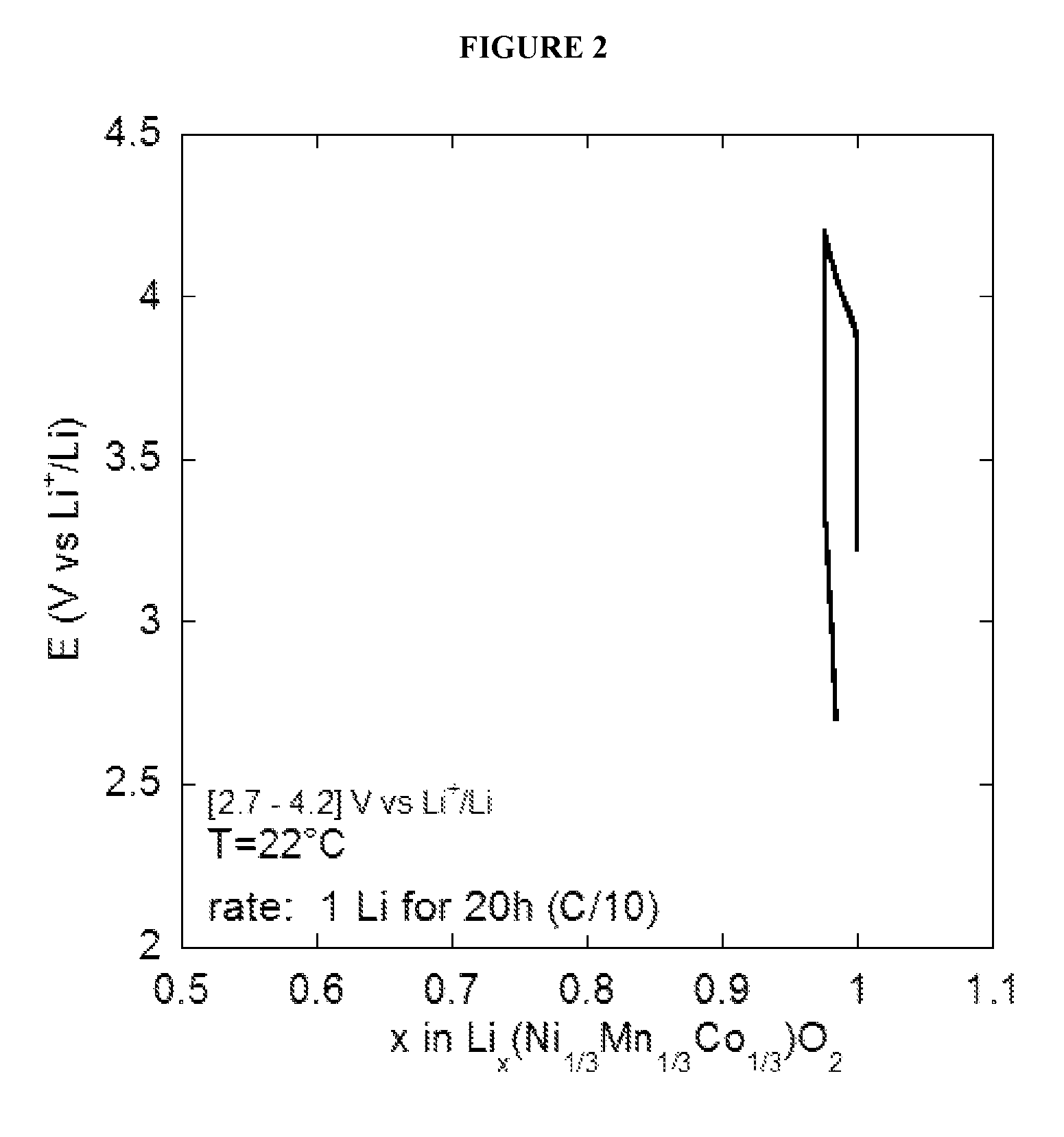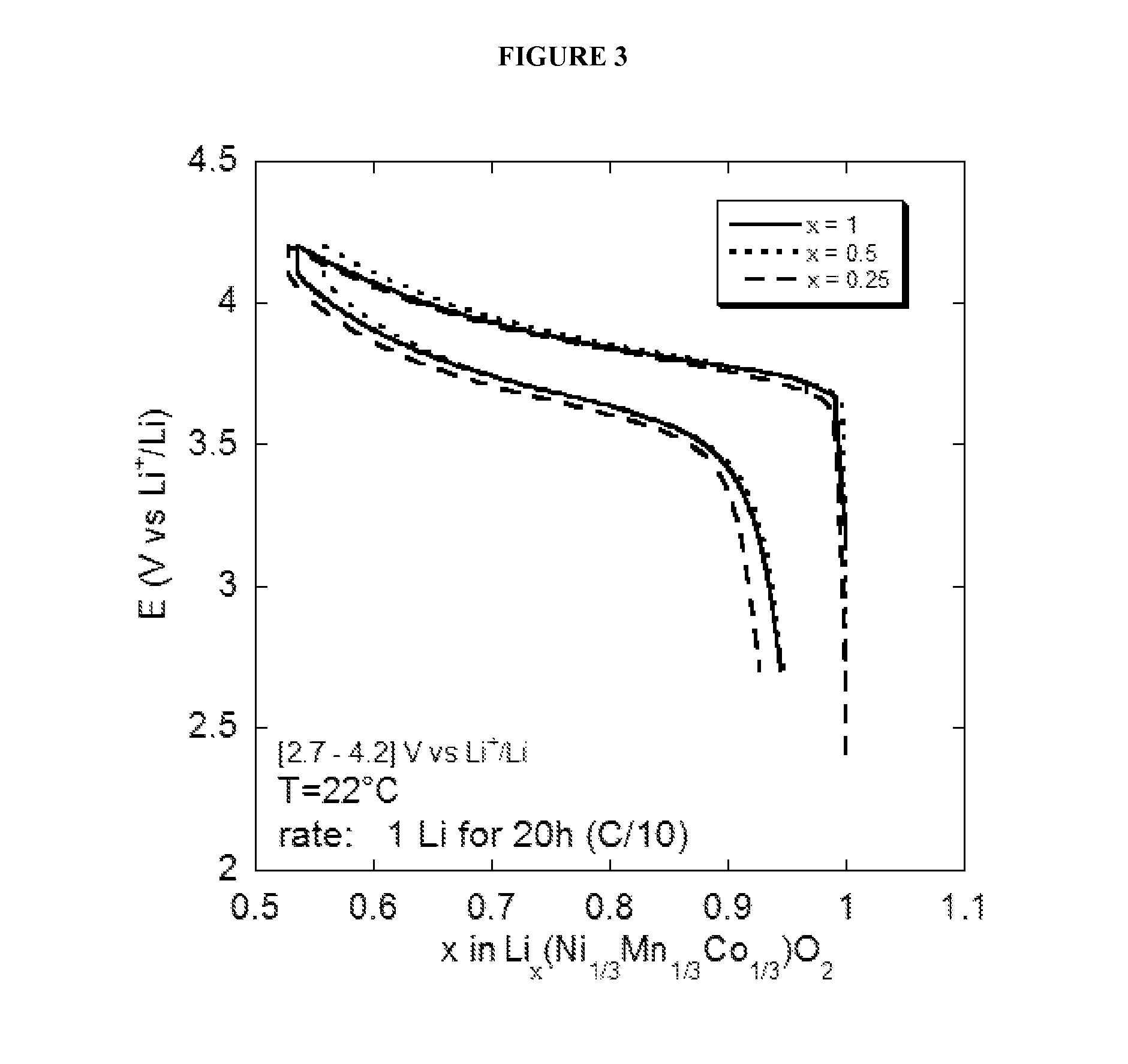High-energy non-aqueous batteries containing ion-conducting gels, and method for preparing and using same
a technology of ion-conducting gel and high-energy non-aqueous batteries, which is applied in the field of high-energy non-aqueous batteries, can solve the problems of low energy density per unit of surface area and high water conten
- Summary
- Abstract
- Description
- Claims
- Application Information
AI Technical Summary
Benefits of technology
Problems solved by technology
Method used
Image
Examples
example 1
Composite Electrode on which a Separately-Synthesized Ionogel is to be Deposited
1.1. Operating Method
1.1.1. General Synthesis of Ionogels
[0106]a) An electrolyte is synthesized using a mixture of the ionic liquid 1-methyl-1-propylpyrrolidinium bis(trifluoromethylsulphonyl)imide (Py13-TFSI) or the ionic liquid 1-methyl-1-propylpiperidinium bis(trifluoromethylsulphonyl)imide (PP13-TF SI) and a lithium salt (LiTFSI). The concentration of LiTFSI is set between 0.1 and 2 mol·L−1. This mixture is called solution 1.
[0107]b) A mixture of a volume of tetramethoxysilane (TMOS) with a volume of methyltrimethoxysilane (MTMS) is produced. This mixture is called solution 2.
[0108]c) Synthesis of the sol: the electrolyte (solution 1) is mixed with the silica precursor (solution 2) according to the proportions by weight given in Table 1 and Table 2 below.
[0109]
TABLE 1Proportions by weight used for the synthesis of ionogels Py13-TFSI-LiTFSI (Py13-TFSI + 0.5 mol / L LiTFSI):Molar ratioElectrolyte mass (g...
example 2
Electrode Prepared According to the Invention
1.1. Operating Method
[0115]An electrolyte is used that was previously synthesized from a mixture of 8.0709 g of Py13-TFSI and 0.8119 g of LiTFSI, i.e. an electrolyte of type Py13-TFSI+0.35 mol / kg LiTFSI (i.e. approximately 0.5 mol / L).
[0116]0.4645 g of this electrolyte is used, mixed with 0.2948 g of the TMOS-MTMS mixture in a glass tablet bottle. A sol is thus obtained having a molar ration of ionic liquid to silicon of 0.5. It is mixed for 1 hour using a magnetic stirring bar.
[0117]200 μL of this mixture is then removed and poured onto the (porous) composite electrode of Li1Ni1 / 3Mn1 / 3Co1 / 3O2 type. The ionogel remaining is left in the glass tablet bottle, in order to ascertain the gelation time. In this case, the gelation time is 30 hours.
[0118]After 30 hours, the gelled composite electrode is placed in an oven at T=100° C. under vacuum for 24 hours.
[0119]The composite electrode that has been “ionogelized” in this way, having a continuous...
example 3
Measurement of the Effect of the Base Weight on Electrochemical Performance
3.1. Operating Method
[0124]The Li1Ni1 / 3Mn1 / 3Co1 / 3O2 / solid electrolyte (ionogel) / Li accumulator prepared in Example 2 is placed in a sealed Swagelok® type electrochemical cell. This step is carried out in a glove box, in which the moisture and oxygen levels are less than 5 ppm. The charge-discharge experiments are carried out using a VMP (Bio-Logic) multi-way potentiostat / galvanostat linked to a computer and controlled by the EC-Lab (Bio-Logic) software.
[0125]Charge-discharge experiments with accumulators are carried out at constant current. The current is calculated and set by the user so that one mole of lithium ions is inserted (or extracted) in a time period set by the user (generally 20 hours). This time defines the charge-discharge rate of the accumulator. Cycling is carried out within a window of potential comprised between 2.7 V and 4.5 V vs Li+ / Li. The cycling temperature is set by the user, by placin...
PUM
| Property | Measurement | Unit |
|---|---|---|
| Fraction | aaaaa | aaaaa |
| Time | aaaaa | aaaaa |
Abstract
Description
Claims
Application Information
 Login to View More
Login to View More - R&D
- Intellectual Property
- Life Sciences
- Materials
- Tech Scout
- Unparalleled Data Quality
- Higher Quality Content
- 60% Fewer Hallucinations
Browse by: Latest US Patents, China's latest patents, Technical Efficacy Thesaurus, Application Domain, Technology Topic, Popular Technical Reports.
© 2025 PatSnap. All rights reserved.Legal|Privacy policy|Modern Slavery Act Transparency Statement|Sitemap|About US| Contact US: help@patsnap.com



